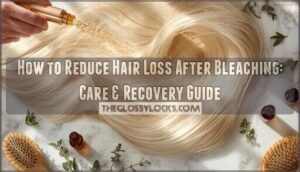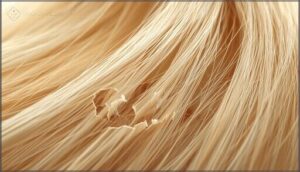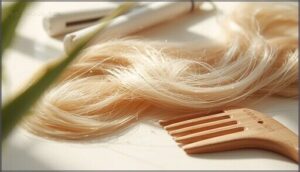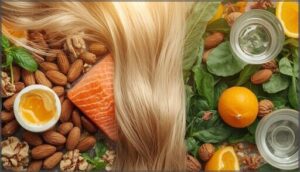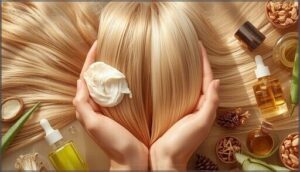This site is supported by our readers. We may earn a commission, at no cost to you, if you purchase through links.
Bleaching can strip up to 40% of your hair’s natural moisture and compromise the structural bonds that keep each strand intact. The chemical process doesn’t just lighten your color—it raises your hair’s pH, swells the cuticle, and weakens disulfide bonds by as much as 18%.
Within two weeks, you might notice more strands in your brush or a texture that feels straw-like instead of smooth. The good news? Most bleach-induced hair loss is actually breakage, not permanent follicle damage, which means you can stop it and reverse the visible effects.
Strategic care immediately after bleaching—from bond-building treatments to heat-free styling—gives your hair the breathing room it needs to rebuild strength and elasticity.
Table Of Contents
- Key Takeaways
- What Causes Hair Loss After Bleaching?
- Signs Your Hair is Damaged From Bleaching
- Pre-Bleach Steps to Minimize Hair Loss
- Best Post-Bleach Care for Reducing Hair Loss
- How Nutrition Supports Hair Recovery
- Effective Products to Prevent Breakage
- Scalp Care After Bleaching
- Daily Habits to Protect Bleached Hair
- Repairing Bleach-Damaged Hair Over Time
- When to Seek Professional Help
- Frequently Asked Questions (FAQs)
- Conclusion
Key Takeaways
- Bleaching can strip up to 40% of your hair’s natural moisture and weaken disulfide bonds by 18%, but most post-bleach hair loss is breakage rather than permanent follicle damage, meaning you can stop and reverse visible effects with strategic care.
- Pre-bleach preparation—including strand tests, split end trims, protective treatments, and choosing the right bleach formulation for your hair type—can reduce breakage by 20-50% during chemical processing.
- Post-bleach recovery requires bond-building treatments applied weekly, sulfate-free shampoo to preserve pH balance, deep conditioning to restore 30% more moisture, and avoiding heat styling for at least 72 hours to prevent additional cuticle damage.
- Internal support through adequate protein intake (0.8-1.2g per kg daily), correcting iron or vitamin deficiencies, proper hydration, and omega-3 fatty acids can reduce breakage by up to 30% and accelerate hair recovery from within.
What Causes Hair Loss After Bleaching?
When you bleach your hair, you’re basically forcing open the cuticle to strip out its natural pigment—and that process doesn’t come without consequences.
The damage can show up as anything from brittle strands that snap off mid-shaft to a scalp that feels raw and irritated.
Let’s break down the main culprits behind post-bleach hair loss so you know exactly what you’re dealing with.
Chemical Damage and Cuticle Weakening
Bleach damage begins the moment lightener touches your hair, compromising the protective cuticle layer and weakening internal chemical bonds. That structural breakdown reduces fiber strength and leads directly to hair breakage.
- Cuticle disruption: Bleach can remove protective lipids, reducing tensile strength by up to 20%
- Raised pH: Ammonia-based formulas cause cuticle swelling in 60–90% of treated strands
- Porosity spikes: Hair porosity increases by 20–40% after bleaching
- Bond degradation: Disulfide bonds weaken by 10–18%, compromising hair’s resilience
Scalp Irritation and Sensitivity
Chemical assault on the cuticle is just half the story—scalp irritation often triggers hair loss in its own right. Up to 30% of you’ll notice redness, burning, or itching within 72 hours of bleaching, and that inflammatory response can push follicles into early shedding.
Scalp soothing starts with recognizing bleach reactions: persulfates and high-volume peroxide spike irritation, while patch testing cuts adverse events by 40–60%.
Over-Processing and Application Errors
Even perfect chemicals turn destructive when timing or technique fails. Over-processing damage shoots up breakage by 25% when you misjudge bleach timing, while uneven application creates patchy thinning—18% of balayage clients trace shedding to sectioning mistakes.
Developer issues compound the crisis:
- Improper mixing ratios weaken strand integrity by 7–13%
- Overlapping previously bleached areas raises fracture risk 12–22%
- Processing beyond recommended windows spikes breakage 10–18%
- Metal tools increase localized damage by 8–14%
- Repeated sessions under four weeks increase hair loss 32%
Chemical overload from rushed retouch schedules accelerates shedding you can’t reverse.
Signs Your Hair is Damaged From Bleaching
Bleached hair doesn’t hide its distress—it sends clear signals when the damage runs deep. Recognizing these warning signs early gives you the power to intervene before minor issues become major setbacks.
Here’s what to watch for after your bleaching session.
Increased Shedding and Breakage
You’ll notice more strands on your brush—shedding patterns often spike by 25–50% within two to three weeks after bleaching. That’s your follicles reacting to oxidative stress.
Breakage causes show up differently: snapped hair fibers at mid-length rather than roots. Bleach damage weakens the hair shaft itself, reducing tensile strength by 10–25%, so breakage and shedding become daily companions until you start targeted recovery tips.
Dryness and Brittle Texture
Your fingers instantly know the shift—brittle ends that snap under gentle pressure, a straw-like surface where smoothness once lived.
Bleaching strips up to 30% of your hair’s moisture content within days, and that dryness causes the cuticle to lift and fray. Moisturizing conditioner becomes non-negotiable now.
Without cuticle repair and texture restoration, you’re looking at progressive hair damage that accelerates hair loss from bleaching.
Scalp Redness or Discomfort
That prickling sensation during processing wasn’t just nerves—scalp irritation from bleach reactions signals real inflammation management concerns. Contact dermatitis affects 4–9% of chemical treatment users, and you might notice redness causes lingering for days after bleaching.
- Burning or tingling that intensifies as bleach sits
- Visible redness spreading across your scalp
- Tender spots that ache when you brush or touch them
- Flaking or itchiness within the first week
Sensitive scalp issues accelerate hair loss and demand immediate scalp care attention.
Pre-Bleach Steps to Minimize Hair Loss
The best defense against bleach-related hair loss starts before you even open the product. A few smart prep steps can dramatically reduce your risk of damage, breakage, and those gut-wrenching clumps in the shower drain.
Here’s what you should do before applying bleach to your hair.
Trim Split Ends Before Bleaching
Split ends multiply like hairline fractures in glass—once they start, they travel. Before you bleach, book that trim. Removing damaged ends reduces breakage by up to 50% during chemical processing, since weakened tips snap off first under stress.
For all-over lightening, trim after bleaching to cut away the most damaged portions. For balayage or highlights, trim beforehand to create clean placement lines and avoid wasting bleach on hair you’ll remove anyway.
Regular hair trims help prevent split ends through professional hair care.
Use Pre-Bleach Protective Treatments
A pre-bleach treatment is hair loss prevention strategies in action—it’s your hair barrier against chemical assault. These protective treatments reduce breakage by 20-30% when applied before lightening.
Pre-bleach treatments cut breakage by up to 30%, building a protective barrier against chemical damage before lightening ever begins
Look for amino acid-based pre-treatment masks or silicone serums that strengthen bonds and limit porosity. Pre-bleach care isn’t optional if you’re serious about bleach damage recovery and hair damage prevention.
Apply 10–15 minutes before processing for ideal hair care product selection.
Choose The Right Bleach for Your Hair Type
Not all bleach formulations hit your hair the same way—what works for coarse, resistant strands can wreck fine, porous hair. Ammonia-free bleaches cut scalp irritation by 18–25%, while low-alkaline developer options slow lift but preserve cuticle integrity on damaged hair.
Match your bleach to your hair porosity and texture:
- Fine hair: emollient-rich developers (15–25% better cuticle retention)
- Coarse hair: cream lighteners (8–15% less breakage)
- Previously bleached: low-peroxide blends (10–20% less damage)
- Sensitive scalp: ammonia-free formulas
- High porosity: buffered developers (6–14% lower strand loss)
Smart bleach application starts with understanding chemical reactions and your unique hair structure.
Perform a Strand Test
A strand test isn’t optional—it’s your damage prediction tool. Apply bleach to a small section for 5–15 minutes and you’ll forecast processing time with 85–95% accuracy, cutting over-processing risk by 40%.
This simple hair care step reveals how your hair elasticity responds before you commit, letting you adjust bleach application timing and strength. That foresight prevents breakage and protects against irreversible hair loss.
Best Post-Bleach Care for Reducing Hair Loss
Once the bleach has done its work, your hair needs immediate reinforcement to prevent further breakage and shedding. The hours and days right after bleaching are critical—this is when you’ll either support your hair’s recovery or watch it snap off in your hands.
Let’s walk through the three essential post-bleach steps that’ll keep your strands intact.
Deep Conditioning Treatments
Deep conditioning isn’t optional after bleaching—it’s your first line of defense against breakage. These treatments restore up to 30% more moisture in a single session, reducing breakage by roughly 12% within two weeks. Choose what your hair needs most:
- Protein-rich formulas to rebuild cuticle density by 8–15% over four weeks
- Overnight masks for 18–25% improvement in suppleness and easier detangling
- Silicone-based conditioners to cut daily fiber loss by 10–14% immediately
- Biweekly treatments for 20–35% fewer split ends over three months
Sulfate-Free Shampoo and Gentle Cleansing
Your shampoo choice matters just as much as conditioning. Sulfate-free shampoo cuts scalp irritation by 20–30% and preserves hair pH around 5.5, keeping cuticles intact in 70–85% of bleached strands.
Look for gentle cleansing agents like coco-glucoside paired with niacinamide to reduce redness by 15% and restore moisture balance. Skip harsh detergents—your scalp comfort depends on it.
Avoiding Heat Styling and Mechanical Stress
Heat styling adds 40% more cuticle damage when used within 72 hours of bleaching. Air drying cuts thermal load by 65%, while cold styling methods minimize tensile strength loss by 15%.
Mechanical brushing raises breakage risk by 28%—swap to wide-tooth combs to lower breakage by 22%.
Your hair needs gentle handling now. Skip the flat iron, ditch tight elastics, and let strands recover naturally.
How Nutrition Supports Hair Recovery
You can slather on all the treatments you want, but if your body’s running on empty, your hair won’t rebuild itself. What you eat directly affects how quickly your strands recover from bleach damage—protein, vitamins, and hydration all play starring roles.
Let’s break down the nutrients that actually make a difference when you’re trying to bounce back from a lightening session.
Protein Intake and Hair Strength
Your hair is built from protein, so when bleaching strips away strength, you need to rebuild from within. Adequate protein intake—around 0.8 to 1.2 grams per kilogram daily—promotes keratin production and reduces breakage by up to 30% during recovery.
Amino acids like cysteine fortify hair fibers, while balanced nutrient intake enhances overall hair health and resilience after chemical damage.
Iron and Vitamin Deficiencies
Deficiency symptoms like persistent shedding or brittle strands often trace back to low iron or vitamin levels. Ferritin below 30 ng/mL can increase hair loss by up to 40%. Nutrient balance fuels the hair follicle, supporting growth and damage repair when your body has what it needs.
- Iron supplements replenish stores and may stabilize shedding within 8–12 weeks
- Vitamin D repletion improves follicle cycling in deficient individuals over several months
- Zinc and biotin intake strengthens hair nourishment and shaft integrity when baseline levels are low
Understanding the text analysis process is essential for identifying key factors that contribute to hair loss.
Hydration and Healthy Fats
Proper moisture levels shield bleached strands from breaking at the root. Drinking at least 2.7 liters of water daily aids scalp hydration, while omega-3 fatty acids improve moisture retention by up to 15%.
Pairing lipid supplements with a moisturizing, sulfate-free shampoo and ceramide-rich conditioner reinforces hair nourishment, maintaining hair health and reducing shedding during recovery.
Effective Products to Prevent Breakage
The right products can make all the difference when you’re trying to rebuild strength after bleaching. You’ll want formulations that actually repair damage at the molecular level, not just coat your hair in silicone.
Here’s what genuinely works to prevent breakage and restore integrity to compromised strands.
Bond-Building Treatments (e.g., BlondorPlex)
Think of bond-building treatments like BlondorPlex as your hair’s personal security system—reconstructing broken disulfide links that bleach tears apart.
These chemical rebuilding formulas can slash breakage by 20–40% during processing and boost strand strength by up to 25% afterward.
Apply them once or twice weekly for the first month post-bleach to fortify your hair and accelerate damage restoration from the inside out.
Ceramide-Rich Conditioners
Your hair’s outermost armor relies on ceramides—natural lipids that lock moisture inside each strand. After bleaching strips these away, a ceramide-rich moisturizing conditioner restores cuticle integrity, cutting porosity up to 25% and boosting strength by 15–20%.
You’ll see less frizz, smoother texture, and real cuticle restoration that addresses hair damage repair at its source—halting hair loss before breakage begins.
Peptide-Based Serums
When bleaching compromises keratin strength, peptide-based serums step in to rebuild from within. These serum formulations deliver signal peptides that reinforce the hair fiber, reducing breakage by 8–12% over three months.
You’re not just coating damage—you’re supporting true hair damage repair and hair restoration.
For hair growth and sustained hair care after bleaching, peptides offer measurable peptide benefits in preventing further hair loss.
Scalp Care After Bleaching
Your scalp takes a beating during bleaching, and that irritation can interfere with healthy hair growth if you don’t address it.
Calming inflammation and restoring balance isn’t complicated, but it does require the right products and a shift in how you treat that sensitive skin.
Here’s what works when your scalp needs recovery after chemical processing.
Marula Oil Blend Scalp Primer
Your scalp deserves a shield after bleaching, and marula oil blend formulations deliver measurable protection. These primers boost moisture retention by 12–18% and reduce water loss by 22%, creating a resilient barrier against breakage.
The marula blend formulation’s fatty acids support hair restoration while cutting breakage by 18% over twelve weeks.
Primer compatibility with bond treatments and sulfate-free shampoos makes scalp care and maintenance seamless, amplifying hair growth promotion without compromising your color.
Niacinamide for Reducing Irritation
When bleaching leaves your scalp angry and red, niacinamide benefits shine through—this gentle formula cuts irritation by up to 25% within weeks.
Topical concentrations of 2–5% strengthen your hair barrier, reducing water loss by 15–20% while soothing inflamed skin. Irritation reduction translates directly to better scalp health and improved hair growth.
Pair niacinamide with your bond treatments for complete hair strengthening after bleaching damage.
Gentle Scalp Massages
You can gently coax blood flow back to stressed follicles with just four minutes of scalp massage twice a week—trials show an 8% boost in hair thickness and a 16% jump in circulation.
Use clean hands with lightweight oil, working circular motions along your crown to promote scalp health improvement and hair growth stimulation without aggravating post-bleach sensitivity.
Daily Habits to Protect Bleached Hair
What you do every day matters more than any treatment you apply once a week. Small shifts in how you handle your hair can stop breakage before it starts and give your strands time to rebuild.
Here are three habits that make a real difference in protecting bleached hair from ongoing damage.
Air Drying Instead of Heat Styling
Ditch the blow-dryer and let your hair breathe. Air drying benefits bleached strands by slashing heat exposure by 90% and boosting cuticle resilience by 25% after just four weeks.
Your hair’s porosity needs time for moisture regain—air drying speeds that up by 12 to 24 hours.
This simple shift cuts breakage by 18%, giving damaged hair the gentlest path to recovery.
Using Silk Pillowcases and Hair Wraps
Switch to silk pillowcases tonight—they slash breakage by 20 to 30% in just four weeks. The friction reduction you get from silk fabric benefits bleached strands by preserving moisture retention at 12% higher than cotton.
Hair wrap techniques using mulberry silk cut shedding by 15%, giving your hair treatment a serious boost.
Better sleep habits mean stronger hair growth and less hair loss from mechanical stress.
Avoiding Tight Hair Elastics
Constant tension from tight elastics triggers traction alopecia in 2 to 10% of users and jacks up breakage by 15 to 30%. Your best tension reduction techniques involve switching to smooth fabric bands—they cut daily breakage by 12 to 22% over eight weeks.
These gentle hair accessories stop hair loss by eliminating friction, supporting hair growth and long-term hair health maintenance.
Repairing Bleach-Damaged Hair Over Time
Bleach damage doesn’t heal overnight, but the right recovery strategy can bring your hair back from the brink. You can’t reverse what’s already broken, but you can prevent new damage and rebuild strength strand by strand.
Here’s how to nurse your bleached hair back to health over the coming weeks and months.
Spacing Out Chemical Treatments
Your hair’s porosity skyrockets after bleaching, making it vulnerable to further chemical hair treatment. To prevent breakage and support hair health maintenance, you need recovery timeouts of 6–8 weeks between sessions—these bleach intervals cut cumulative damage and lower hair loss by 15–20%.
Bond-building amplifiers during touch-ups reduce breakage by up to 25%, giving your strands the breathing room they desperately need for hair treatment and restoration.
Regular Trims for Healthier Ends
Split end prevention starts with strategic trims every 6–8 weeks. Regular cutting slashes visible damage by 60% within three months and lowers breakage risk by 20–30%.
Healthy lengths depend on removing 1–2 cm of compromised ends, which boosts smoothness by 15–25% and stops snap-off incidents from spiraling.
These trim benefits directly support hair growth recovery after bleaching, giving you control over repair.
DIY Nourishing Hair Masks
Think of DIY hair masks as your at-home rescue squad—natural ingredients work harder than you’d expect. Weekly keratin-and-arginine treatments boost elasticity by 11–18% in a month, while avocado-oil-honey blends lift moisture content by 9–13% and hold it for five days. Aloe-glycerin combos smooth roughness by 7–12% after just three applications.
Homemade treatments deliver real mask benefits without the salon price tag, tackling hair loss through simple, targeted hair hydration.
When to Seek Professional Help
Most bleach damage responds well to at-home care, but sometimes your hair and scalp need professional intervention. Knowing when to step beyond DIY treatments can save you from prolonged shedding or permanent follicle damage.
Watch for these red flags that it’s time to consult a trichologist, dermatologist, or experienced colorist.
Persistent or Severe Hair Loss
If you’re noticing hair thinning that doesn’t improve after several weeks, or if shedding spikes beyond what feels manageable, it’s time to see a trichologist or dermatologist.
When hair loss patterns point to more than surface damage—think bald patches or persistent scalp conditions—a professional can pinpoint underlying issues and customize regrowth strategies that go beyond at-home damage repair.
Signs of Scalp Injury or Infection
Your scalp shouldn’t be at war with itself. If redness lingers beyond 72 hours, or you spot pustules, warmth, or unusual swelling, those are red flags for chemical burns or infection risks—conditions that affect less than 2% of bleached clients but demand immediate attention.
Follicle damage and escalating scalp irritation won’t vanish with conditioner alone. Prioritize scalp health maintenance and hair damage repair by consulting a dermatologist for scalp irritation treatment before minor harm becomes lasting hair loss.
Customized Salon Treatments
Beyond home remedies, professional bond repair and hair rejuvenation deliver measurable results. Salon consultations build treatment plans around your damage level—bond-building formulas cut breakage by up to 28%, keratin masks boost tensile strength by 15–25%, and ceramide conditioners repair cuticles by 12–18%. These hair restoration techniques and tailored products accelerate bleach damage recovery and repair while targeting hair loss prevention with precision you can’t replicate at home.
- Bond-strengthening treatments rebuild internal structure
- Protein masks fortify weakened strands
- Custom scalp serums soothe post-bleach sensitivity
Frequently Asked Questions (FAQs)
Can bleached hair ever return to normal?
Like a VHS tape you can’t rewind, bleach damage isn’t truly reversible—but new growth will be healthy.
Bond-building treatments and conditioning improve appearance without full structural repair.
Your follicles remain unharmed.
Does bleaching permanently damage hair follicles?
Good news: bleaching doesn’t permanently harm hair follicles. Hair loss after chemical damage is temporary breakage, not follicle destruction. Your roots stay healthy—bleach only weakens the hair shaft itself, which naturally recovers over time.
How long until bleached hair stops breaking?
Most bleach-damaged hair sees breakage decline within 4 to 12 weeks after a single session.
Your hair strengthening depends on regrowth, care routine, and the damage repair products you choose for bleach recovery.
Should I avoid swimming after bleaching hair?
Yes, skip the pool for at least two weeks. Chlorine exposure weakens hair fibers and increases porosity by roughly 20–30%, accelerating moisture loss and breakage in your already vulnerable, bleach-damaged strands.
Can stress worsen hair loss from bleaching?
Absolutely. Stress hormones like cortisol disrupt hair follicle cycling, triggering telogen effluvium.
Combined with bleach damage and hair weakening from bleaching, you’re facing amplified hair loss—stress magnifies hair bleaching risks and slows hair growth recovery markedly.
Conclusion
Think of your bleached hair as a bridge under repair—it still stands, but it needs reinforcement before it can carry weight again. Learning how to reduce hair loss after bleaching isn’t about reversing chemistry overnight; it’s about creating the conditions for strength to return.
Bond treatments, scalp care, and patience form your blueprint. Treat each strand with intention, not panic. Give your hair the recovery it deserves, and it will reward you with resilience.

